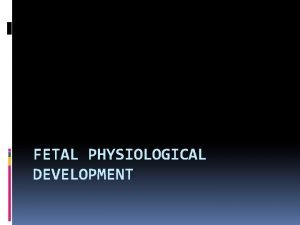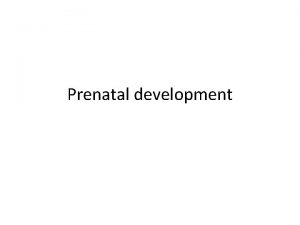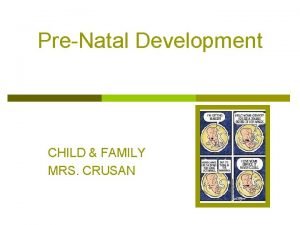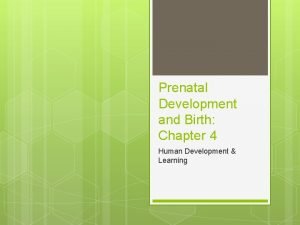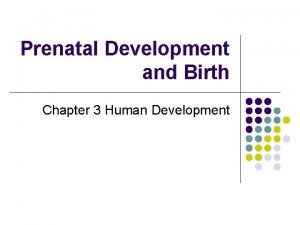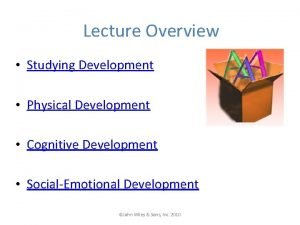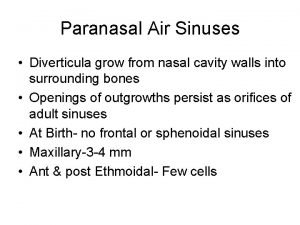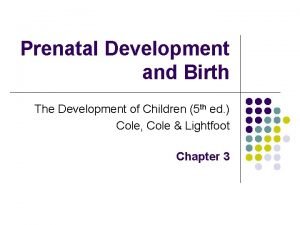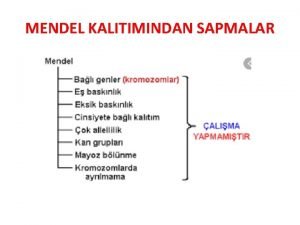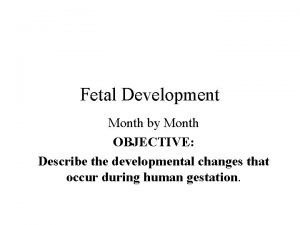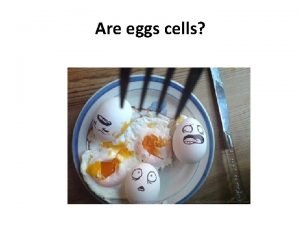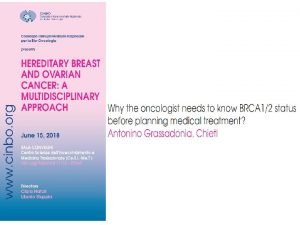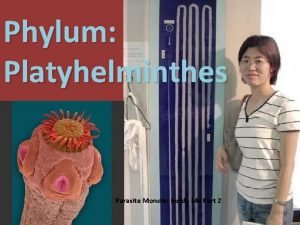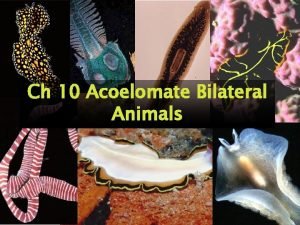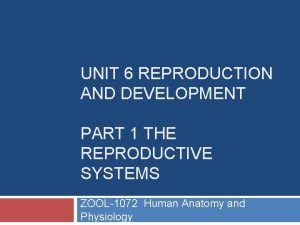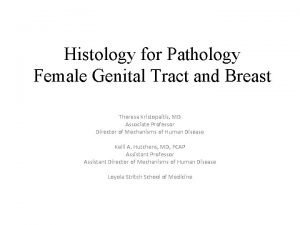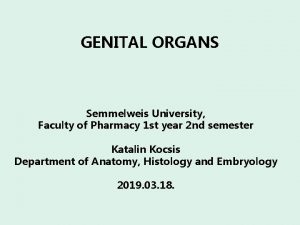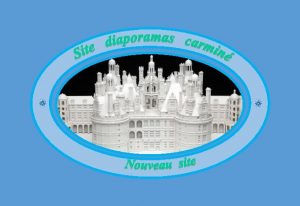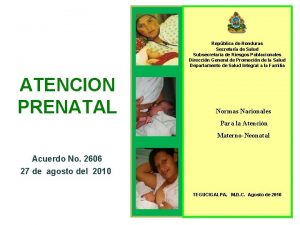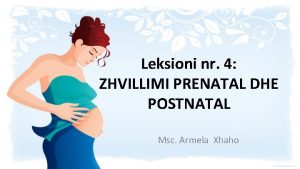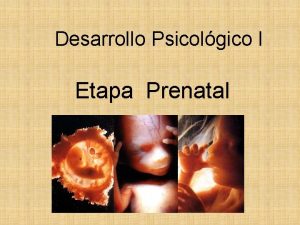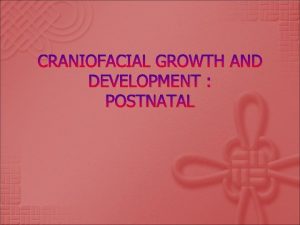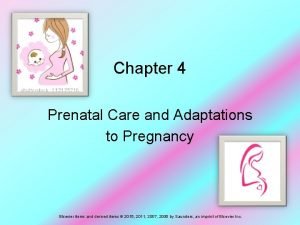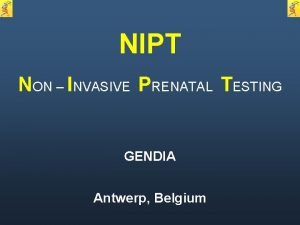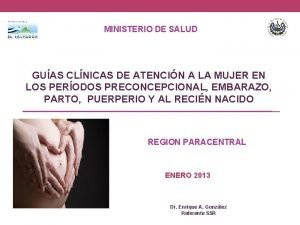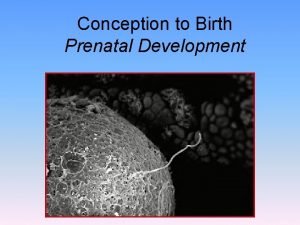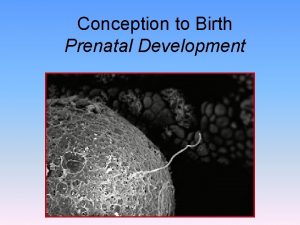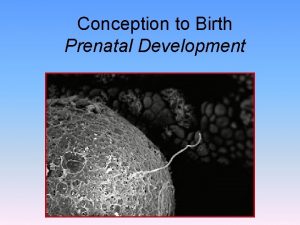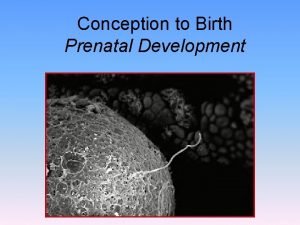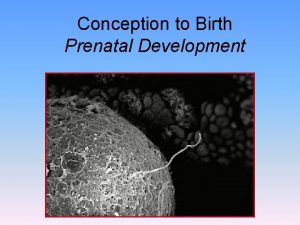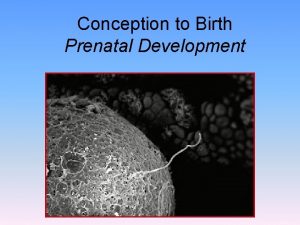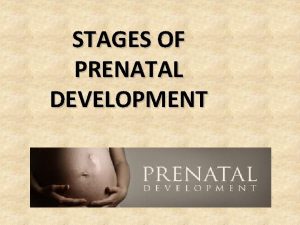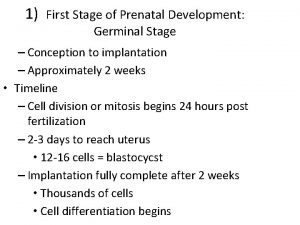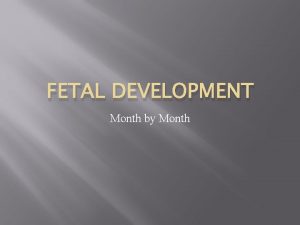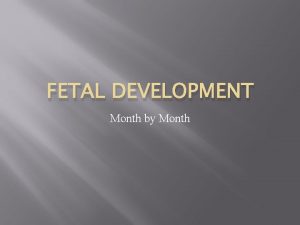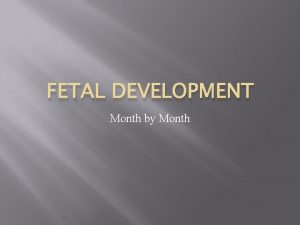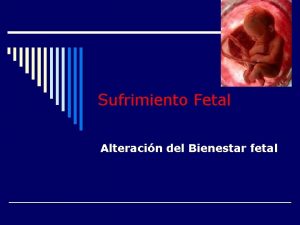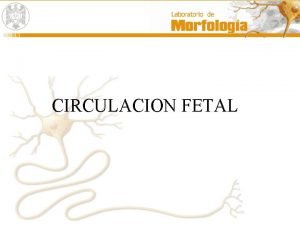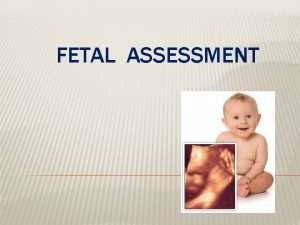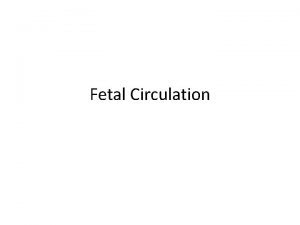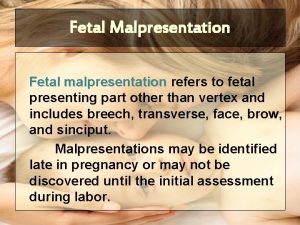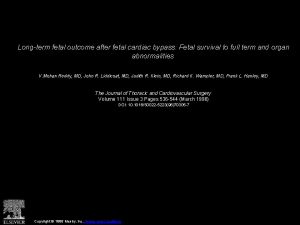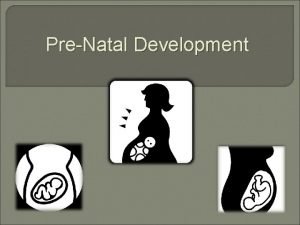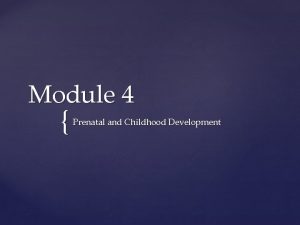FETAL PHYSIOLOGICAL DEVELOPMENT Prenatal development Ovular period germinal





































- Slides: 37

FETAL PHYSIOLOGICAL DEVELOPMENT

Prenatal development Ovular period / germinal period Embryonic period- CRL is 4 mm Fetal period.

Principal events Day 14 -21_ notochord Day 21 -28_ neural fold fuse to form neural tube, heart beat Week 4 -6 post conception-face. Limb buds, optic vesicle Weeks 6 -8_ all major structures form Weeks 8 -12 – external genital Week 20 – skin is covered by lanugo Week 28 - testes descend to int inguinal ring Week 36 - one testes inti scrotum Week 40 both testes descend, nail, post. fontonelle

CARDIOVASCULAR SYSTEM Fetal Circulation Nutrients for growth and development are delivered from the umbilical vein in the umbilical cord → placenta → fetal heart

Fetal Circulation Oxygenated blood from mother ↓ (via umbilical vein) Liver Portal sinus Ductus venosus ↓ Inferior vena cava (mixes with deoxygenated blood) ↓ Right atrium

Right atrium ↓ (through Foramen ovale) Left atrium ↓ Left ventricle ↓ (through Aorta) Heart and Brain

Deoxygenated blood from lower half of fetal body ↓ Inferior vena cava Deoxygenated blood flowing through Superior vena cava Right atrium ↓ Right ventricle

Right ventricle ↓ Pulmonary artery ↓ (through Ductus arteriosus) Descending aorta ↓ Hypogastric arteries ↓ Umbilical arteries ↓ Placenta

Fetal Circulation Source: http: //images. google. com. ph

Differences in Fetal and Adult Circulation st 1 difference: Presence of shunts which allow oxygenated blood to bypass the right ventricle and pulmonary circulation, flow directly to the left ventricle, and for the aorta to supply the heart and brain 3 shunts: - Ductus venosus - Foramen ovale - Ductus arteriosus

Differences in Fetal and Adult Circulation 2 nd difference: Ventricles of the fetal heart work in parallel compared to the adult heart which works in sequence.

Differences in Fetal and Adult Circulation Fetal cardiac output per unit weight is 3 times higher than that of an adult at rest. This compensated for low O 2 content of fetal blood. Is accomplished by ↑ heart rate and ↓ peripheral resistance

Changes After Birth Clamped cord + fetal lung expansion = constricting and collapsing of umbilical vessels, ductus arteriosus, foramen ovale, ductus venosus Fetal circulation changes to that of an adult

Changes After Birth: Closing of Shunts Shunt Ductus arteriosus Functional closure Anatomical closure Remnant 10 – 96 hrs after 2 – 3 wks after Ligamentum birth arteriosum Formamen Within several ovale mins after birth One year after Fossa ovalis birth Ductus venosus 3 – 7 days after birth Within several mins after birth Umbilical arteries → Umbilical ligaments Umbilical vein → Ligamentum teres Ligamentum venosum

Changes After Birth Maintenance of ductus arteriosus depends on: - difference in blood pressure bet. Pulmonary artery and aorta - difference in O 2 tension of blood passing through ductus. ↑ p O 2 = stops flow. Mediated through prostaglandins.

Fetal Blood Hematopoiesis First seen in the yolk sac during embryonic period (mesoblastic period) Liver takes over up to term (hepatic period) Bone marrow: starts hematopoietic function at around 4 months fetal age; major site of blood formation in adults (myeloid period)

Fetal Blood Hematopoiesis Erythrocytes progress from nulceated to nonnucleated Blood vol. and Hgb concentration increase progressively Midpregnancy: Hgb 15 gms/dl Term: 18 gms/dl

Fetal Blood Hematopoiesis Fetal erythrocytes: 2/3 that of adult’s (due to large volume and more easily deformable) During states of fetal anemia: fetal liver synthesizes erythropoietin and excretes it into the amniotic fluid. (for erythropoiesis in utero)

Fetal Blood Volume Average volume of 80 ml/kg body wt. right after cord clamping in normal term infants Placenta contains 45 ml/kg body weight Fetoplacental blood volume at term is approx. 125 ml/kg of fetus

Fetal Blood Fetal Hemoglobin Type Description Chains Hemoglobin F Fetal Hgb or alkalineresistant Hgb 2 alpha chains, 2 gamma chains Hemoglobin A Adult Hgb. Formed starting at 32 -34 wks gestation and results from methylation of gamma globin chains Hemoglobin Present in mature fetus in A 2 small amounts that increase after birth 2 alpha chains, 2 beta chains 2 alpha chains, 2 delta chains

Fetal Blood Fetal Hemoglobin Fetal erythrocytes that contain mostly Hgb F bind more O 2 than Hgb A erythrocytes Hgb A binds more 2 -3 BPG more tightly than Hgb F (this lowers affinity of Hgb for O 2) Increased O 2 affinity of fetal erythrocytes results from lower concentartion of 2 -3 BPG in the fetus Affinity of fetal blood for O 2 decreases at higher temp. (maternal hyperthermia)

Oxygen dissociation curve of fetal and maternal blood Source: http: //www. colorado. edu/intphys/Class/IPHY 3430 -200/image/18 -12. jpg

Fetal Blood Fetal Coagulation Factors Contains lowers levels of coagulation factors II, VI, IX, X, XII, XIII and fibrinogen (vit. K dependent factors) Routine prophylaxis of vit. K injections to prevent hemorrhagic disease of the newborn Platelet count is normal Thrombin time prolonged Factor XIII (fibrin stabilizing factor) & plasminogen lower than adult Low level of factor VIII → hemophilia in male infants

Fetal Blood Fetal Plasma Proteins and Blood Viscosity Mean total plasma protein, Plasma albumin concentration, and Blood viscosity: similar in maternal & fetal blood Increased viscosity in fetal blood: due to higher Hct. Is offset by lower levels of fibrinogen and Ig. M, and by more deformable erythrocytes

Fetal Blood Immunocompetence of Fetus Ig. G from mother begins at around 16 wks and is most pronounce during last 4 wks or pregnancy Newborns produce Ig. G and adult values are reached at 3 years old Ig. M produced by fetus in response to congenital infections (Rubella, CMV, Toxoplasmosis) Adult levels of Ig. M attained by 9 mos old

Fetal Blood B lymphocytes appear in liver by 9 wks gestation, and seen in the blood and spleen by 12 wks gestation T lymphocytes produced by thymus at 14 wks Monocytes of newborns able to process and present antigen when tested w/ maternal antigenspecific T-cells

Fetal Blood Ontogeny of the Immune Response Hemolytic disease of the newborn: maternal antibodies to fetal erythrocyte antigen cross the placenta to destroy fetal erythrocytes Fetus is immunologically competent at 13 wks AOG Synthesis of complement in late 1 st trimester. At term, complement levels are ½ of adults

Fetal Blood Ontogeny of the Immune Response Newborn responds poorly to immunization (due to deficient response of newborn B cells or lack of T cells) Only Ig. A from colostrum may protect against enteric infections Ig. M predominantly produced in response to antigenic stimulation. Identification may help diagnose intrauterine infections

NERVOUS SYSTEM and SENSORY ORGANS Sufficient development of synaptic functions are signified by flexion of fetal neck & trunk If fetus is removed from the uterus during the 10 th wk, spontaneous movements may be observed although movements in utero aren’t felt by the mother until 18 -20 wks

NERVOUS SYSTEM and SENSORY ORGANS Gestational age 10 wks Fetal development 12 wks Squinting, opening of mouth, incomplete finger closure, plantar flexion of toes, swallowing and respiration Taste buds evident histologically 16 wks Complete finger closure 24 – 26 wks Ability to suck, hears some sounds 28 wks Eyes sensitive to light, responsive to variations in taste of ingested substances

DIGESTIVE SYSTEM 11 wks gestation → peristalsis in small intestine, transporting glucose actively 16 wks gestation → able to swallow amniotic fluid, absorb much water from it, and propel unabsorbed matter to lowe colon Hydrochloric acid & other digestive enzymes present in very small amounts

DIGESTIVE SYSTEM Term fetuses can swallow 450 ml amniotic fluid in 24 hours This regulates amniotic fluid volume: - inhibition of swallowing (esophageal atresia) = Polyhydramnios Amniotic fluid contributes little to caloric requirements of fetus, but contributes essential nutrients: 0. 8 gms of soluble protein is ingested daily by the fetus from amniotic fluids. Half is alubumin.

DIGESTIVE SYSTEM Meconium passed after birth Dark greenish black color of meconium caused by bile pigments (esp. biliverdin) Meconium passage during labor due to hypoxia (stimulates smooth muscle of colon to contract) Small bowel obstruction may lead to vomiting in utero Fetuses with congenital chloride diarrhea may have diarrhea in utero. Vomiting and diarrhea in utero may lead to polyhydramnios and preterm delivery

DIGESTIVE SYSTEM Liver and Pancreas Fetal liver enzymes reduced in amount compared to adult Fetal liver has limited capacity to convert free bilirubin to conjugated bilirubin Fetus produces more bilirubin due to shorter life span of fetal erythrocytes. Small fraction is conjugated and excreted and oxidized to biliverdin Much bilirubin is transferred to the placenta and to the maternal liver for conjugation and excretion

DIGESTIVE SYSTEM Fetal pancreas responds to hyperglycemia by ↑ insulin Insulin containing granules identified in fetal pancreas at 9 -10 wks. Insulin in fetal plasma detectable at 12 wks. Insulin levels: ↑ in newborns of diabetic mothers and LGAs (large for gestational age); ↓in infants who are SGA (small for gestational age)

endocrinology Growth hormone, ACTH, prolactin, TSH and gonadotrophic hormones- pituitary -10 wk 12 wk- vasopressin and oxytocin- post pituitary Small amount of thyroxin- 11 wk

Thank you
 Ovular period
Ovular period First stage of prenatal development
First stage of prenatal development 3 stages of prenatal development
3 stages of prenatal development Periods of prenatal development
Periods of prenatal development Fetal stage
Fetal stage 3 stages of prenatal development
3 stages of prenatal development Prenatal development
Prenatal development Late fetal period
Late fetal period Germinal stage
Germinal stage Germinal stage diagram
Germinal stage diagram Germinal stage
Germinal stage Okovani prometej analiza
Okovani prometej analiza Ekivalentlik
Ekivalentlik Embryonic stage
Embryonic stage Sel germinal
Sel germinal Shell cleanliness shell soundness shell texture shell shape
Shell cleanliness shell soundness shell texture shell shape Germinal disc in egg
Germinal disc in egg Bracaness
Bracaness Parasitism phylum
Parasitism phylum 3 germinal layers
3 germinal layers Monogenea
Monogenea Tapeworms structure
Tapeworms structure Germinal epithelium
Germinal epithelium Tunica albuginea of ovary
Tunica albuginea of ovary Germinal epithelium
Germinal epithelium Coelomic epithelium
Coelomic epithelium Marius colluci
Marius colluci Carnet prenatal honduras
Carnet prenatal honduras Carole osborne sheets
Carole osborne sheets Eksoderma
Eksoderma Hitos del desarrollo adolescencia
Hitos del desarrollo adolescencia Etapa prenatal del desarrollo humano
Etapa prenatal del desarrollo humano Prenatal growth of cranial base
Prenatal growth of cranial base Chapter 4 prenatal care and adaptations to pregnancy
Chapter 4 prenatal care and adaptations to pregnancy What is nipt test
What is nipt test Hoja filtro control prenatal
Hoja filtro control prenatal Vitamed prenatal
Vitamed prenatal Estapa prenatal
Estapa prenatal
